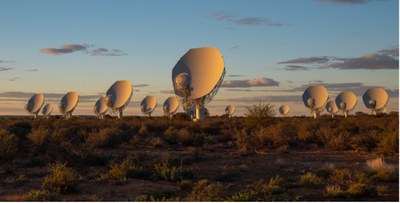Exploring Cosmic Mysteries: How Student Researchers Are Key to Unveiling Galaxy Evolution
June 24, 2024
By Stephanie Godward, Communications and Marketing Director, College of Arts & Sciences
In the vast expanse of the universe, galaxies hold secrets to our cosmic past. Modern technology in the form of a revolutionary telescope located in South Africa is now giving UofL’s College of Arts & Sciences students and faculty newfound power to tell these stories – some of which are billions of years old - with the data that’s being collected.
Physics and Astronomy Professor Benne Holwerda is leading a groundbreaking research initiative recently funded by NASA with over $300,000 of support for these stories to be told. This project, centered on the "Gas Economy – Star Formation and Gas Supply in Galaxies Over Cosmic Times," aims to unravel these mysteries of galaxy evolution.
The Research Mission
Galaxies, like our Milky Way, evolve over billions of years, transforming gas into stars. Through powerful telescopes like the MeerKAT Radio Telescope in South Africa, part of the LADUMA project, researchers can peer back nearly 8 billion years. This deep dive into cosmic history allows them to witness how galaxies formed and evolved over time.
“The further down you look in time by using this telescope, which is the largest radio telescope ever built, you see the first galaxies – it is a time machine,” Holwerda states. “We look as far back as we can, combine it with other telescopes, and see how galaxies form and evolve.”
Student Involvement
Undergraduate and graduate students play a crucial role in this pioneering research. Senior graduate student Kyle Cook will oversee a small team of undergraduate researchers each year, mentoring them in hands-on research. This involvement isn't just about learning—it's about contributing to real scientific discovery.
Students will engage in synthesizing vast amounts of telescope data, constructing Spectral Energy Distributions (SEDs) that reveal the star formation rates and comparing those to the gas content of galaxies. This experience is not only enriching but also prepares them for future careers in astronomy and related fields.
Learning Opportunities
Participating students will gain skills in scientific programming, data visualization (through tools like Python), and thesis writing through honors programs. Depending on the individual student’s goals, they will have various options for engaging with the research in a way that works for them, Professor Holwerda states. Students will also have opportunities to present their findings at local meetings with astronomers in addition to prestigious conferences, such as the American Astronomical Society meetings, networking with leading researchers in the field.

Impact and Future Goals
The ultimate goal of this research is profound: to understand how galaxies evolve and how their star formation processes change over cosmic epochs. By leveraging advanced telescope technologies and interdisciplinary approaches, Professor Holwerda's team aims to deepen our understanding of the universe's evolution.
This collaborative effort not only pushes the boundaries of scientific knowledge but also equips students with invaluable experience and skills, paving the way for future discoveries in astronomy and beyond.
Join us in following this exciting journey into the cosmos as we uncover the stories galaxies tell through their starry transformations. Thanks to Professor Holwerda’s work and research, we will discover more about the depths of space and time, driven by his team’s curiosity and quest for knowledge.
